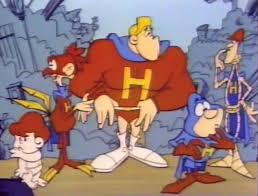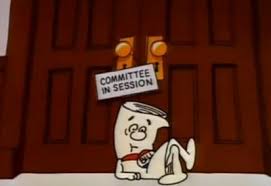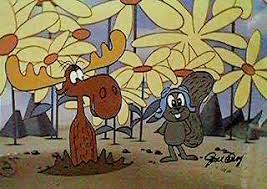The Television Era of Animation is also known as the Dark Age of Animation. Animation went from innovative mass entertainment for children and adults to being strictly regulated for children. The process of animation became cheap and economical and a lot of the theatrical quality and creativity did not translate to the limitations of weekly television. But the TV era took place across thirty years and there was a lot of cartoons produced for TV. As much as this era is looked down upon animator's did manage to create several quality shows. These were the highlights of the sixties and seventies. The one's that hold up against the view of history.

10. The Mighty Heroes (21 episodes, 1966, CBS)
Ralph Bakshi's TV series was short lived but certainly stands out among the other comedies of the period. This is a precursor to Mighty Mouse: The New Adventures, which went on to be one of the most important cartoon's of the renaissance. Mighty Heroes did not have much lasting popularity and the characters have been used sparingly. But this is a rare example of a wacky television cartoon that is not based around stock gags or a laugh track.
9. Tom Terrific (26 episodes, 1957-1959, CBS)
This aired in five minutes segments as part of Captain Kangaroo. All in black and white with very limited animation. But it does hold the personality and artistic stamp of creator Gene Deitch. The concept is that the boy can turn into anything and has adventures with Manfred the Wonder Dog. Just full of imagination, which was something that many television cartoons sadly lacked.

8. Schoolhouse Rock (64 episodes, 1973-1985, ABC)
One of the few educational cartoons that I would actually call educational. Decades after these aired my ninth grade English teacher showed us these and we actually learned a lot about grammar. These are effective, memorable and creative shorts. Both animation and education strive with being accessible and fun, too bad the two do not always work well together.
7. Fat Albert and the Cosby Kids (110 episodes, 1972-1985, CBS and Syndication)
Educational cartoons were not a huge industry in the seventies and eighties. Usually educational content in cartoons during this time were a formality to keep watchdog groups satisfied. But Fat Albert was actually created around morals. The setting of Fat Albert is interesting because it was familiar to the target audience. Fat Albert targeted and understood children that entertainment often ignores. This is also the perfect example of celebrity involvement in animation. Bill Cosby was not just allowing his name to be used for marketing purposes, this was his concept and he believed in the mission of it.
6. Jonny Quest (26 episodes, 1964-1965, ABC)
Hanna-Barbera was able to reuse concepts and designs time and time again. But every now and then they were able to create something truly unique. Jonny Quest holds up well. The animation is certainly limited and made for the assembly line, but the backgrounds and settings are above average. Also it is notable how the humans are designed realistically rather than caricatured. At the time this series was controversial for violence and suspense, it certainly holds up as a fun adventure.
Hanna-Barbera was able to reuse concepts and designs time and time again. But every now and then they were able to create something truly unique. Jonny Quest holds up well. The animation is certainly limited and made for the assembly line, but the backgrounds and settings are above average. Also it is notable how the humans are designed realistically rather than caricatured. At the time this series was controversial for violence and suspense, it certainly holds up as a fun adventure.
5. Beany and Cecil (26 episodes, 1962, ABC)
Bob Clampett is best known for directing classic Looney Tunes such as Porky in Wackyland, Porky's Duck Hunt and The Great Piggy Bank Robbery, but the legendary animator created some of television's first enduring and most imaginative characters. The animation in Beany and Cecil is much cleaner than most sixties animation and the characters are better designed. It did not last long on TV and its eighties update by John Kricfalusi was even shorter, but it certainly stands out among the bland efforts of the television era.
4. Peanuts specials (45 specials, 1965-present, CBS, NBC, ABC and Fox)
I should probably mention the Dr. Seuss and Rankin-Bass specials on this list, but I have mentioned Christmas specials many other times on this blog. But I really wanted to mention the Peanuts special because Charlie Brown and animation have had a mutually beneficial relationship for over fifty years. Charles Schulz was heavily involved in A Charlie Brown Christmas (the best holiday special of all time) and several other classics. Not all of the Charlie Brown cartoons are hits, but at their very worst they feature the great humor of Charles Schulz. One of the best innovations of the television era was the annual special. The Charlie Brown and Snoopy cartoons are still loved and seen by many every year.
I should probably mention the Dr. Seuss and Rankin-Bass specials on this list, but I have mentioned Christmas specials many other times on this blog. But I really wanted to mention the Peanuts special because Charlie Brown and animation have had a mutually beneficial relationship for over fifty years. Charles Schulz was heavily involved in A Charlie Brown Christmas (the best holiday special of all time) and several other classics. Not all of the Charlie Brown cartoons are hits, but at their very worst they feature the great humor of Charles Schulz. One of the best innovations of the television era was the annual special. The Charlie Brown and Snoopy cartoons are still loved and seen by many every year.
3. Disneyland (hard to say, 1954-1986, ABC, NBC and CBS)
Disney was able to benefit from television unlike any other. Instead of just selling his filmography to networks Walt was proactive and produced the best television entertainment of the time. Animation in particular benefited from the anthology series as old shorts and movies were able to find new audiences and be reused in new ways. However unlike other theatrical short showcases such as The Woody Woodpecker Show or the Looney Tunes anthologies the cartoons were really only edited for time not content. But the long running TV show did not just reuse old material, it created new animation such as those found in the legendary Tomorrowland episodes and even created a memorable new character, Ludwig von Drake. This was animated by Walt's top-notch staff and was lead by many animation luminaries, most notably Ward Kimball. The series also was able to give audiences a look behind the scenes in episodes such as The Plausible Impossible. Walt Disney's anthology series did not exclusively feature animation, but it was always impressive when it did.

Disney was able to benefit from television unlike any other. Instead of just selling his filmography to networks Walt was proactive and produced the best television entertainment of the time. Animation in particular benefited from the anthology series as old shorts and movies were able to find new audiences and be reused in new ways. However unlike other theatrical short showcases such as The Woody Woodpecker Show or the Looney Tunes anthologies the cartoons were really only edited for time not content. But the long running TV show did not just reuse old material, it created new animation such as those found in the legendary Tomorrowland episodes and even created a memorable new character, Ludwig von Drake. This was animated by Walt's top-notch staff and was lead by many animation luminaries, most notably Ward Kimball. The series also was able to give audiences a look behind the scenes in episodes such as The Plausible Impossible. Walt Disney's anthology series did not exclusively feature animation, but it was always impressive when it did.
2. Rocky and Bullwinkle (163 episodes, 1959-1964, ABC and NBC)
Chuck Jones dubbed television animation, "illustrated radio." This was because these cartoons relied on scripts, voice acting and soundtracks to overcome limited animation. The best illustrated cartoon was definitely the works of Jay Ward. These cartoons were really nothing special to look at, although the characters had memorable designs. But the jokes were sharp and nonstop and the voice acting was top-notch. Rocky and Bullwinkle was Jay Ward's greatest success. Relevant, yet timeless. It managed to combine lowbrow humor with wit and intelligence. This cartoon could even be considered a precursor to South Park. Rocky and Bullwinkle holds up as one of the best television shows of all time, animated or otherwise.
Chuck Jones dubbed television animation, "illustrated radio." This was because these cartoons relied on scripts, voice acting and soundtracks to overcome limited animation. The best illustrated cartoon was definitely the works of Jay Ward. These cartoons were really nothing special to look at, although the characters had memorable designs. But the jokes were sharp and nonstop and the voice acting was top-notch. Rocky and Bullwinkle was Jay Ward's greatest success. Relevant, yet timeless. It managed to combine lowbrow humor with wit and intelligence. This cartoon could even be considered a precursor to South Park. Rocky and Bullwinkle holds up as one of the best television shows of all time, animated or otherwise.
1. The Flintstones (166 episodes, 1960-1966, ABC)
Hanna-Barbera really owned television animation for thirty years. They were prolific and created many memorable, marketable characters. However they never animated anything as good as The Flintstones. The Flintstones is not a masterpiece, it is derivative and not well animated. But the visual style, stock jocks and characters are iconic. This series is possibly the only television cartoon that was equally enjoyed by children and adults. This was something families watched together and enjoyed together. It managed to succeed in primetime for six years and even received a nomination for Best Comedy (something only Family Guy would accomplish in 2009, in a year with seven nominees). This series is fun and has reached a status of timeless. The franchise definitely seems to hold diminishing returns, the spin-offs and movies not being all that great. But the original series was revolutionary and represents the best of the television era of animation.
Hanna-Barbera really owned television animation for thirty years. They were prolific and created many memorable, marketable characters. However they never animated anything as good as The Flintstones. The Flintstones is not a masterpiece, it is derivative and not well animated. But the visual style, stock jocks and characters are iconic. This series is possibly the only television cartoon that was equally enjoyed by children and adults. This was something families watched together and enjoyed together. It managed to succeed in primetime for six years and even received a nomination for Best Comedy (something only Family Guy would accomplish in 2009, in a year with seven nominees). This series is fun and has reached a status of timeless. The franchise definitely seems to hold diminishing returns, the spin-offs and movies not being all that great. But the original series was revolutionary and represents the best of the television era of animation.

No comments:
Post a Comment